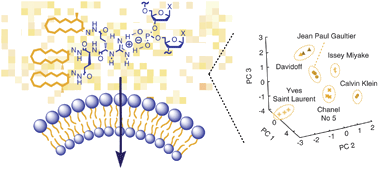- Takeuchi, T.; Montenegro, J.; Hennig, A.; Matile, S. “Pattern Generation with Synthetic Sensing Systems in Lipid Bilayer Membranes” Chem. Sci. 2011, 2, 303-307

The objective of this study was to introduce differential sensing techniques to synthetic systems that act, like olfactory receptors, as transporters in lipid bilayer membranes. Routine with most alternative chemosensing ensembles, pattern generation has, quite ironically, remained inaccessible in lipid bilayers because the number of available crossresponsive sensor components has been insufficient. To address this challenge, we here report on the use of cationic hydrazides that can react in situ with hydrophobic analytes to produce cationic amphiphiles which in turn can act as countercation activators for polyanionic transporters in fluorogenic vesicles. To expand the dimension of signals generated by this system, a small collection of small peptides containing a positive charge (guanidinium, ammonium) and one to three reactive hydrazides are prepared. Odorants are used as examples for hydrophobic analytes, perfumes to probe compatibility with complex matrices, and counterion-activated calf-thymus DNA as representative polyion-counterion transport system. Principal component and hierarchical cluster analysis of the obtained multidimensional patterns are shown to differentiate at least 21 analytes in a single score plot, discriminating also closely related structures such as enantiomers, cis-trans isomers, single-atom homologs, as well as all tested perfumes. Inverse detection provides access to analytes as small as acetone. The general nature of the introduced methodology promises to find diverse applications in current topics in biomembrane research.
DOI: 10.1039/C0SC00386G
open archive unige:13220 • pdf ![]()
